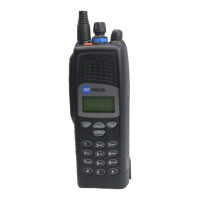TP9100 Service Manual Receiver Fault Finding 253
© Tait Electronics Limited May 2005
11.2 Excessive Loss of Sensitivity
Introduction This section covers the case where the receiver has suffered an excessive loss
of sensitivity. As measured in Task 1, the receiver gain will be less than 1500,
which implies a sensitivity that is more than 40dB too low. The fault-
diagnosis procedure for this case consists of five tasks:
■ Task 2: check power supplies
■ Task 3: check logic signal
■ Task 4: check lock status
■ Task 5: check biasing of IF amplifier
■ Task 6: check matching circuitry
If the fault does not lie with the power supplies, it is probably in the control,
LO, IF1 or IF2 circuitry.
Tas k 2 —
Check Power
Supplies
First check the two power supplies 3V0 AN and 3V0 RX for the receiver
circuitry.
1. Remove the main board from the chassis.
2. Check for 3.0V DC (3
V0 AN) at the TP3V0 AN test point near the
speaker pin (see Figure 12.3 on page 273).
3. If the voltage is correct, go to Step 4. If it is not, the 3V regulator
IC604 is suspect; go to Ta s k 4
of “Power Supply Fault Finding” on
page 156.
4. Remove the
LO2 TOP can.
5. Check for 3.0V DC (3
V0 RX) around the collector feed to Q402 or
Q403 of LO2 (see Figure 11.2).
Alternative measurement points are the collector feed to Q401 of the
RF LNA under the
RX FE TOP can (see Figure 11.3) or Q404 of the
IF amplifier under the
IF IQ BOT can (see Figure 11.1).
6. If the voltage is correct, go to Ta s k 3
. If it is not, the 3V RX switch
(based on Q603 and Q604) in the PSU module is suspect; go to
Task 4
of “Power Supply Fault Finding” on page 156.
TP3V0 AN test point: 3.0V DC
Q402 or Q403 collector: 3.0V DC

